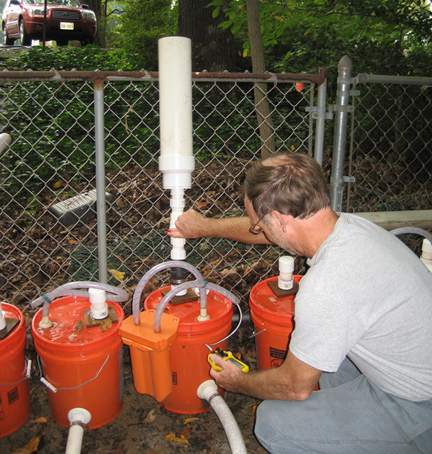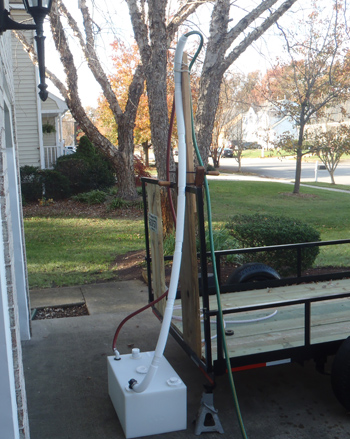
Take a look at this photo and imagine it is your backyard. Or your patio, or balcony. Yep, those are sealed 5-gallon buckets full of iguana poop and other waste, ripening in the Chesapeake Bay area’s autumn sun.
Do you ever wonder whether those bright blue bottles of chemicals that claim to eliminate your head odors actually work? So did we. Did you ever wonder how the neighbors would react if you set up a head odor testing facility in your backyard? So did PS contributor Drew Frye. So far, it seems, Operation Potty Odor, has not alarmed the local zoning tipsters, but it is yielding some interesting results.
They [the neighbors] have learned not to ask questions about what goes on over here, says Drews wife, Laura, only half-joking.
The February issue of Practical Sailor, due out next week, features the results of our first two articles in a series on controlling head odors. For the main article, a test of odor-control chemicals, Frye collected, flushed, stored, and sniffed (both with his nose and a four-gas sensor) iguana poop and other waste, then added various products designed to control odor. Yes, I did say iguana poop. It came-if you must ask-courtesy of the Frye family pet, Ziggy.
Readers may remember Frye as the tester who nearly reduced the family washing machine to a bucket of bolts in his quest for a safe and effective method for washing ropes. Hes just that kind of guy.
The results of Fryes olfactory adventures so far are mixed. As Frye is quick to point out, chemical additives are just part of the equation, and likely a small one. The real trick to achieving a sweet-smelling boat is in designing a system that promotes the biological processes that help eliminate odor. Cut off air-flow, and youre sealing in the stink. Add chemicals, like chlorine or formaldehyde-still found in some products despite its recent classification as a known carcinogen-and you may stop the process altogether.
Apart from Fryes finding that a holding tank is an excellent reservoir for highly explosive gases, one of his more exciting discoveries was that any product’s claims of odor-eating bacteria” should not be taken at face value. Fryes attempts to nurture a bacterial culture from the four products that made this claim failed in all but one case. And wouldnt you know it? The most effective product that used active bacteria – as opposed to enzymes, bleaches, and perfumes – is no longer on the market. When we called Dustin Stroth to tell him his VanishOdor product was holding its own in Fryes test, he sighed, as if hed expected as much. The Sarasota, Fla. entrepreneur who developed the product had recently decided to throw in the towel after several years of lukewarm sales.

Im not surprised, he said. Its a good product, but it never really caught on. Stroth shut down the supply line last fall. I had bills to pay, and it was time to move on to something else.
Stroth says he still has a few bottles on hand, and his website is still up for orders. Anyone who wants to give the product a whirl can order some of the remaining stock from his website, www.vanishodor.com. Because this is a product that boosts the biological processes, it will not work as well in poorly-ventilated holding tanks. Warmer temperatures are preferred. Our test identifies four other products that will effectively combat holding tank odors, one for less than $10 per season.

In a companion article to Fryes piece on holding tank chemical treatments, tester Frank Lanier looks at holding tanks. For this test, he pits the Trionic holding tank against the latest polyethylene tank from SeaLand. Lanier is also located in the Chesapeake area. Judging from the pictures, the test platform for his project took up a good portion of his front driveway. All for a good cause, as they say.








































I am researching products to help remove odor from the be holding tank.It was there when we purchased our houseboat but my husband died recently so I am trying to learn and do whatever I can. I am painting the boat right now for inspection and I don’t have a lot of money so any advise would be helpful. You may also call me. Betty Homa 760-975-1578. Oceanside Harbor, California Thank you